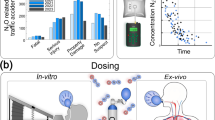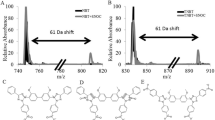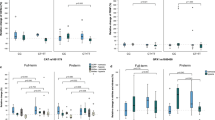Abstract
The oxidative environment within the lung generated upon administration of oxygen may be a critical regulator for the efficacy of inhaled nitric oxide therapy, possibly as a consequence of changes in nitrosative and nitrative chemistry. Changes in S-nitrosocysteine and 3-nitrotyrosine adducts were therefore evaluated after exposure of rats to 80% or >95% oxygen for 24 or 48 h with and without 20 ppm inhaled nitric oxide. Exposure to 80% oxygen led to increased formation of S-nitrosocysteine and 3-nitrotyrosine adducts in lung tissue that were also associated with increased expression of iNOS. The addition of inhaled nitric oxide in 80% oxygen exposure did not alter any of these adducts in the lung or in the bronchoalveolar lavage (BAL). Exposure to >95% oxygen led to a significant decrease in S-nitrosocysteine and an increase in 3-nitrotyrosine adducts in the lung. Co-administration of inhaled nitric oxide with >95% oxygen prevented the decrease in S-nitrosocysteine levels. The levels of S-nitrosocysteine and 3-nitrotyrosine returned to baseline in a time-dependent fashion after termination of exposure to >95% oxygen and inhaled nitric oxide. These data suggest the formation of S-nitrosating and tyrosine-nitrating species is regulated by oxygen tensions and co-administration of inhaled nitric oxide restores the nitrosative chemistry without a significant impact upon the nitrative pathway.
Similar content being viewed by others
Log in or create a free account to read this content
Gain free access to this article, as well as selected content from this journal and more on nature.com
or
Abbreviations
- 3NT:
-
3-nitrotyrosine
- BAL:
-
bronchoalveolar lavage
- CLD:
-
chronic lung disease
- ECMO:
-
extracorporeal membrane oxygenation
- NO:
-
nitric oxide
- eNOS:
-
endothelial nitric oxide synthase
- iNOS:
-
inducible nitric oxide synthase
- nNOS:
-
neuronal nitric oxide synthase
- PPHN:
-
persistent pulmonary hypertension
- SNO:
-
S-nitrosothiol
References
Clark RH, Kueser TJ, Walker MW, Southgate WM, Huckaby JL, Perez JA, Roy BJ, Keszler M, Kinsella JP 2000 Low-dose nitric oxide therapy for persistent pulmonary hypertension of the newborn. Clinical Inhaled Nitric Oxide Research Group. N Engl J Med 342: 469–474.
The Neonatal Inhaled Nitric Oxide Study Group, 1997 Inhaled nitric oxide in full-term and nearly full-term infants with hypoxic respiratory failure. N Engl J Med 336: 597–604.
Kinsella JP, Truog WE, Walsh WF, Goldberg RN, Bancalari E, Mayock DE, Redding GJ, deLemos RA, Sardesai S, McCurnin DC, Moreland SG, Cutter GR, Abman SH 1997 Randomized, multicenter trial of inhaled nitric oxide and high-frequency oscillatory ventilation in severe, persistent pulmonary hypertension of the newborn. J Pediatr 131: 55–62.
Davidson D, Barefield ES, Kattwinkel J, Dudell G, Damask M, Straube R, Rhines J, Chang CT 1998 Inhaled nitric oxide for the early treatment of persistent pulmonary hypertension of the term newborn: a randomized, double-masked, placebo-controlled, dose-response, multicenter study. The I-NO/PPHN Study Group. Pediatrics 101: 325–334.
Kinsella JP, Walsh WF, Bose CL, Gerstmann DR, Labella JJ, Sardesai S, WalshSukys MC, McCaffrey MJ, Cornfield DN, Bhutani VK, Cutter GR, Baier M, Abman SH 1999 Inhaled nitric oxide in premature neonates with severe hypoxaemic respiratory failure: a randomised controlled trial. Lancet 354: 1061–1065.
Banks BA, Seri I, Ischiropoulos H, Merrill J, Rychik J, Ballard RA 1999 Changes in oxygenation with inhaled nitric oxide in severe bronchopulmonary dysplasia. Pediatrics 103: 610–618.
Schreiber MD, Gin-Mestan K, Marks JD, Huo D, Lee G, Srisuparp P 2003 Inhaled nitric oxide in premature infants with the respiratory distress syndrome. N Engl J Med 349: 2099–2107.
Ischiropoulos H, Zhu L, Chen J, Tsai M, Martin JC, Smith CD, Beckman JS 1992 Peroxynitrite-mediated tyrosine nitration catalyzed by superoxide dismutase. Arch Biochem Biophys 298: 431–437.
Beckman JS, Koppenol WH 1996 Nitric oxide, superoxide, and peroxynitrite: the good, the bad, and ugly. Am J Physiol 271:C1424–C1437.
Gow A, Duran D, Thom SR, Ischiropoulos H 1996 Carbon dioxide enhancement of peroxynitrite-mediated protein tyrosine nitration. Arch Biochem Biophys 333: 42–48.
Royall JA, Kooy NW, Beckman JS 1995 Nitric oxide-related oxidants in acute lung injury. New Horiz 3: 113–122.
Crapo JD, Barry BE, Foscue HA, Shelburne J 1980 Structural and biochemical changes in rat lungs occurring during exposures to lethal and adaptive doses of oxygen. Am Rev Respir Dis 122: 123–143.
Lorch SA, Foust R, Gow A, Arkovitz M, Salzman AL, Szabo C, Vayert B, Geffard M, Ischiropoulos H 2000 Immunohistochemical localization of protein 3-nitroty-rosine and S-nitrosocysteine in a murine model of inhaled nitric oxide therapy. Pediatr Res 47: 798–805.
Jankov RP, Johnstone L, Luo X, Robinson BH, Tanswell AK 2003 Macrophages as a major source of oxygen radicals in the hyperoxic newborn rat lung. Free Radic Biol Med 35: 200–209.
van der Vliet A, Eiserich JP, Halliwell B, Cross CE 1997 Formation of reactive nitrogen species during peroxidase-catalyzed oxidation of nitrite. A potential additional mechanism of nitric oxide-dependent toxicity. J Biol Chem 272: 7617–7625.
Brennan ML, Wu W, Fu X, Shen Z, Song W, Frost H, Vadseth C, Narine L, Lenkiewicz E, Borchers MT, Lusis AJ, Lee JJ, Lee NA, Abu-Soud HM, Ischiropoulos H, Hazen SL 2002 A tale of two controversies: defining both the role of peroxidases in nitrotyrosine formation in vivo using eosinophil peroxidase and myeloperoxidase-deficient mice, and the nature of peroxidase-generated reactive nitrogen species. J Biol Chem 277: 17415–17427.
Narasaraju TA, Jin N, Narendranath CR, Chen Z, Gou D, Liu L 2003 Protein nitration in rat lungs during hyperoxia exposure: a possible role of myeloperoxidase. Am J Physiol Lung Cell Mol Physiol 285:L1037–L1045.
Gutierrez HH, Nieves B, Chumley P, Rivera A, Freeman BA 1996 Nitric oxide regulation of superoxide-dependent lung injury: oxidant-protective actions of endogenously produced and exogenously administered nitric oxide. Free Radic Biol Med 21: 43–52.
Howlett CE, Hutchison JS, Veinot JP, Chiu A, Merchant P, Fliss H 1999 Inhaled nitric oxide protects against hyperoxia-induced apoptosis in rat lungs. Am J Physiol 277:L596–L605.
Stamler JS, Lamas S, Fang FC 2001 Nitrosylation. The prototypic redox-based signaling mechanism. Cell 106: 675–683.
Molina y Vedia L, McDonald B, Reep B, Brune B, Di Silvio M, Billiar TR, Lapetina EG 1992 Nitric oxide-induced S-nitrosylation of glyceraldehyde-3-phosphate dehydrogenase inhibits enzymatic activity and increases endogenous ADP-ribosylation. J Biol Chem 267: 24929–24932.
Xu L, Eu JP, Meissner G, Stamler JS 1998 Activation of the cardiac calcium release channel (ryanodine receptor) by poly-S-nitrosylation. Science 279: 234–237.
Kim YM, Talanian RV, Billiar TR 1997 Nitric oxide inhibits apoptosis by preventing increases in caspase-3-like activity via two distinct mechanisms. J Biol Chem 272: 31138–31148.
Mannick JB, Hausladen A, Liu L, Hess DT, Zeng M, Miao QX, Kane LS, Gow AJ, Stamler JS 1999 Fas-induced caspase denitrosylation. Science 284: 651–654.
Banks BA, Ischiropoulos H, McClelland M, Ballard PL, Ballard RA 1998 Plasma 3-nitrotyrosine is elevated in premature infants who develop bronchopulmonary dysplasia. Pediatrics 101: 870–874.
Viera L, Ye YZ, Estevez AG, Beckman JS 1999 Immunohistochemical methods to detect nitrotyrosine. Methods Enzymol 301: 373–381.
Geffard M, Dulluc J, Rock AM 1985 Antisera against the indolealkylamines: tryptophan, 5-hydroxytryptophan, 5-hydroxytryptamine, 5-methoxytryptophan, and 5-methoxytryptamine tested by an enzyme-linked immunosorbent assay method. J Neurochem 44: 1221–1228.
Fries DM, Paxinou E, Themistocleous M, Swanberg E, Griendling KK, Salvemini D, Slot JW, Heijnen HF, Hazen SL, Ischiropoulos H 2003 Expression of inducible nitric-oxide synthase and intracellular protein tyrosine nitration in vascular smooth muscle cells: role of reactive oxygen species. J Biol Chem 278: 22901–22907.
Cucchiaro G, Tatum AH, Brown MC, Camporesi EM, Daucher JW, Hakim TS 1999 Inducible nitric oxide synthase in the lung and exhaled nitric oxide after hyperoxia. Am J Physiol 277:L636–L644.
Ischiropoulos H 2003 Biological selectivity and functional aspects of protein tyrosine nitration. Biochem Biophys Res Commun 305: 776–783.
Moya MP, Gow AJ, McMahon TJ, Toone EJ, Cheifetz IM, Goldberg RN, Stamler JS 2001 S-nitrosothiol repletion by an inhaled gas regulates pulmonary function. Proc Natl Acad Sci U S A 98: 5792–5797.
Gaston B, Reilly J, Drazen JM, Fackler J, Ramdev P, Arnelle D, Mullins ME, Sugarbaker DJ, Chee C, Singel DJ, Loscalzo J, Stamler J 1993 Endogenous nitrogen oxides and bronchodilator S-nitrosothiols in human airways. Proc Natl Acad Sci U S A 90: 10957–10961.
Bannenberg G, Xue J, Engman L, Cotgreave I, Moldeus P, Ryrfeldt A 1995 Characterization of bronchodilator effects and fate of S-nitrosothiols in the isolated perfused and ventilated guinea pig lung. J Pharmacol Exp Ther 272: 1238–1245.
Haddad IY, Pataki G, Hu P, Galliani C, Beckman JS, Matalon S 1994 Quantitation of nitrotyrosine levels in lung sections of patients and animals with acute lung injury. J Clin Invest 94: 2407–2413.
Kobayashi H, Hataishi R, Mitsufuji H, Tanaka M, Jacobson M, Tomita T, Zapol WM, Jones RC 2001 Antiinflammatory properties of inducible nitric oxide synthase in acute hyperoxic lung injury. Am J Respir Cell Mol Biol 24: 390–397.
Wong HR, Carcillo JA, Burckart G, Kaplan SS 1996 Nitric oxide production in critically ill patients. Arch Dis Child 74: 482–489.
Baines PB, Stanford S, Bishop-Bailey D, Sills JA, Thomson AP, Mitchell JA, Fear SC, Hart CA, Petros AJ 1999 Nitric oxide production in meningococcal disease is directly related to disease severity. Crit Care Med 27: 1187–1190.
Liu L, Yan Y, Zeng M, Zhang J, Hanes MA, Ahearn G, McMahon TJ, Dickfeld T, Marshall HE, Que LG, Stamler JS 2004 Essential roles of s-nitrosothiols in vascular homeostasis and endotoxic shock. Cell 116: 617–628.
Author information
Authors and Affiliations
Corresponding author
Additional information
Supported by National Institutes of Health, National Heart, Lung, and Blood Institute grant number HL-54926 and a Forrest Pharmaceutical Advancing Neonatal Care Grant.
Rights and permissions
About this article
Cite this article
Lorch, S., Munson, D., Lightfoot, R. et al. Oxygen Tension and Inhaled Nitric Oxide Modulate Pulmonary Levels of S-Nitrosocysteine and 3-Nitrotyrosine in Rats. Pediatr Res 56, 345–352 (2004). https://doi.org/10.1203/01.PDR.0000134256.30519.9B
Received:
Accepted:
Issue date:
DOI: https://doi.org/10.1203/01.PDR.0000134256.30519.9B
This article is cited by
-
Inhaled Nitric Oxide Prevents 3-Nitrotyrosine Formation in the Lungs of Neonatal Mice Exposed to >95% Oxygen
Lung (2010)
-
Normoxic Resuscitation after Cardiac Arrest Protects against Hippocampal Oxidative Stress, Metabolic Dysfunction, and Neuronal Death
Journal of Cerebral Blood Flow & Metabolism (2006)



